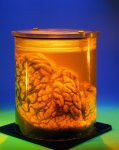Cultivating Cognition: The "Brain Fitness" Movement
 One topic of increasing popular interest is "brain fitness," or how to maintain and further develop cognitive abilities. One need not look farther than the current sudoku craze to see that people everywhere are eager to keep themselves mentally engaged. But to what extent can the outlets for this urge be informed by the cognitive and neural sciences?
One topic of increasing popular interest is "brain fitness," or how to maintain and further develop cognitive abilities. One need not look farther than the current sudoku craze to see that people everywhere are eager to keep themselves mentally engaged. But to what extent can the outlets for this urge be informed by the cognitive and neural sciences?At the forefront of this field is Sharp Brains, a company whose advisory board includes several neuroscientists. For example, one of the board members is Dr. Elkhonon Goldberg, professor of Neurology at NYU and author of "The Wisdom Paradox." As reviewed in the popular science press, Goldberg argues that old age need not be viewed solely as a period of cognitive decline, but that instead certain cognitive abilities actually continue to develop beyond adulthood. The book also investigates whether it may be possible to ward off cognitive decline with regular exercise - both mental and physical.
Dr. Juliana Baldo - another member of the Sharp Brains advisory board - has written extensively on the role of language in problem solving and executive function. Baldo has published work that begins to dissociate response interference from "conceptual" interference in the Stroop task, and has also developed an interesting new test of executive function. Much of Baldo's work has involved patients with frontal damage and aphasia.
Sharp Brains has partnered with other companies bringing science-based brain fitness products to market. For example, SharpBrains works with CogMed, a Swedish-startup offering computer-based working memory training for kids with ADHD. The results of such training were published in JAACAP last February, which showed that training improved digit span, Stroop, and Raven's progressive matrices performance, and that these gains were stable at follow-up. It's notable that the effects of CogMed's training seem to transfer or generalize beyond the specifics of their training paradigm.
Perhaps cognitive science's first major commercial application was in the field of human-computer interaction (HCI), where software interfaces are made more usable by incorporating the limits of human cognition as a software design constraint. Clearly, there are many parallels between HCI and the emerging "brain fitness" market, where cognitive science informs the design of software to extend the limits of human cognition. Particularly interesting are the ways in which these two fields might interact.
As in the HCI movement of the 90s, and before that, the Human Factors movement in the 60's and 70s, brain fitness is a field where basic research is being put directly into real-world use. It's important for both the users of these new products and for the field as a whole that these products are grounded in rigorous science.


1 Comments:
nice nice nice! cool stuff!
Post a Comment
<< Home